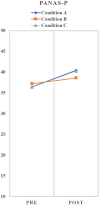Move and Be Moved: The Effect of Moving Specific Movement Elements on the Experience of Happiness
- PMID: 33584414
- PMCID: PMC7874178
- DOI: 10.3389/fpsyg.2020.579518
Move and Be Moved: The Effect of Moving Specific Movement Elements on the Experience of Happiness
Abstract
Dynamic body feedback is used in dance movement therapy (DMT), with the aim to facilitate emotional expression and a change of emotional state through movement and dance for individuals with psychosocial or psychiatric complaints. It has been demonstrated that moving in a specific way can evoke and regulate related emotions. The current study aimed to investigate the effects of executing a unique set of kinetic movement elements on an individual mover's experience of happiness. A specific sequence consisting of movement elements that recent studies have related to the feeling of happiness was created and used in a series of conditions. To achieve a more realistic reflection of DMT practice, the study incorporated the interpersonal dimension between the dance movement therapist (DMTh) and the client, and the impact of this interbodily feedback on the emotional state of the client. This quantitative study was conducted in a within-subject design. Five male and 20 female participants (mean age = 20.72) participated in three conditions: a solo executed movement sequence, a movement sequence executed with a DMTh who attuned and mirrored the movements, and a solo executed movement sequence not associated with feelings of happiness. Participants were only informed about the movements and not the feelings that may be provoked by these movements. The effects on individuals were measured using the Positive and Negative Affect Schedule and visual analog scales. Results showed that a specific movement sequence based on movement elements associated with happiness executed with a DMTh can significantly enhance the corresponding affective state. An additional finding of this study indicated that facilitating expressed emotion through movement elements that are not associated with happiness can enhance feelings such as empowerment, pride, and determination, which are experienced as part of positive affect. The results show the impact of specific full-body movement elements on the emotional state and the support outcome of DMT on emotion regulation.
Keywords: Laban Movement Analysis; body feedback; dance movement therapy; embodiment; emotion; interaffectivity; positive affect.
Copyright © 2021 van Geest, Samaritter and van Hooren.
Conflict of interest statement
The authors declare that the research was conducted in the absence of any commercial or financial relationships that could be construed as a potential conflict of interest.
Figures





Similar articles
-
The role of dance movement therapy in enhancing emotional regulation: A literature review.Heliyon. 2024 Aug 3;10(15):e35733. doi: 10.1016/j.heliyon.2024.e35733. eCollection 2024 Aug 15. Heliyon. 2024. PMID: 39170197 Free PMC article. Review.
-
Emotion Regulation through Movement: Unique Sets of Movement Characteristics are Associated with and Enhance Basic Emotions.Front Psychol. 2016 Jan 11;6:2030. doi: 10.3389/fpsyg.2015.02030. eCollection 2015. Front Psychol. 2016. PMID: 26793147 Free PMC article.
-
How Do We Recognize Emotion From Movement? Specific Motor Components Contribute to the Recognition of Each Emotion.Front Psychol. 2019 Jul 3;10:1389. doi: 10.3389/fpsyg.2019.01389. eCollection 2019. Front Psychol. 2019. PMID: 31333524 Free PMC article.
-
A Somatic Movement Approach to Fostering Emotional Resiliency through Laban Movement Analysis.Front Hum Neurosci. 2017 Sep 7;11:410. doi: 10.3389/fnhum.2017.00410. eCollection 2017. Front Hum Neurosci. 2017. PMID: 28936167 Free PMC article.
-
Dance Movement Therapy for Clients With a Personality Disorder: A Systematic Review and Thematic Synthesis.Front Psychol. 2021 Mar 18;12:581578. doi: 10.3389/fpsyg.2021.581578. eCollection 2021. Front Psychol. 2021. PMID: 33868071 Free PMC article.
Cited by
-
Bodily expressed emotion understanding through integrating Laban movement analysis.Patterns (N Y). 2023 Aug 22;4(10):100816. doi: 10.1016/j.patter.2023.100816. eCollection 2023 Oct 13. Patterns (N Y). 2023. PMID: 37876902 Free PMC article.
-
Exploring the Psychological Effects and Physical Exertion of Using Different Movement Interactions in Casual Exergames That Promote Active Microbreaks: Quasi-Experimental Study.JMIR Serious Games. 2024 Aug 26;12:e55905. doi: 10.2196/55905. JMIR Serious Games. 2024. PMID: 39186776 Free PMC article.
-
The role of dance movement therapy in enhancing emotional regulation: A literature review.Heliyon. 2024 Aug 3;10(15):e35733. doi: 10.1016/j.heliyon.2024.e35733. eCollection 2024 Aug 15. Heliyon. 2024. PMID: 39170197 Free PMC article. Review.
-
"It doesn't feel like exercise": a realist process evaluation of factors that support long-term attendance at dance classes designed for healthy ageing.Front Public Health. 2023 Dec 20;11:1284272. doi: 10.3389/fpubh.2023.1284272. eCollection 2023. Front Public Health. 2023. PMID: 38192566 Free PMC article.
-
Unlocking the Emotional World of Visual Media: An Overview of the Science, Research, and Impact of Understanding Emotion: Drawing Insights From Psychology, Engineering, and the Arts, This Article Provides a Comprehensive Overview of the Field of Emotion Analysis in Visual Media and Discusses the Latest Research, Systems, Challenges, Ethical Implications, and Potential Impact of Artificial Emotional Intelligence on Society.Proc IEEE Inst Electr Electron Eng. 2023 Oct;111(10):1236-1286. doi: 10.1109/JPROC.2023.3273517. Epub 2023 May 23. Proc IEEE Inst Electr Electron Eng. 2023. PMID: 37859667 Free PMC article.
References
-
- Acolin J. (2016). The mind – body connection in dance/movement therapy: theory and empirical support. Am. J. Dance Ther. 38 311–333. 10.1007/s10465-016-9222-4 - DOI
-
- Bartenieff I., Lewis D. (1980). Body Movement: Coping with the Environment. New York, NY: Taylor and Francis.
-
- Bechara A., Damasio A. R. (2005). The somatic marker hypothesis: a neural theory of economic decision. Games Econ. Behav. 52 336–372. 10.1016/j.geb.2004.06.010 - DOI
-
- Bender S. (2007). Die psychophysische Bedeutung der Bewegung: ein Handbuch der Laban Bewegungsanalyse und des Kestenberg Movement Profiles. Berlin: Logos-Verlag.
-
- Betty A. (2013). Taming tidal waves: a dance/movement therapy approach to supporting emotion regulation in maltreated children. Am. J. Dance Ther. 35 39–59. 10.1007/s10465-013-9152-3 - DOI
LinkOut - more resources
Full Text Sources
Other Literature Sources
Miscellaneous

